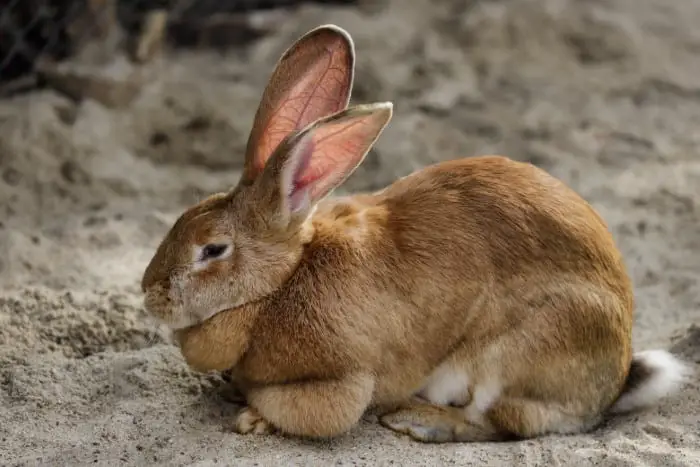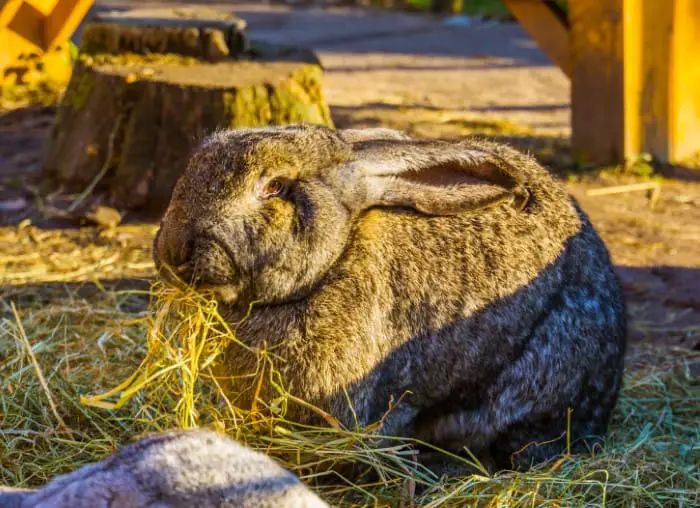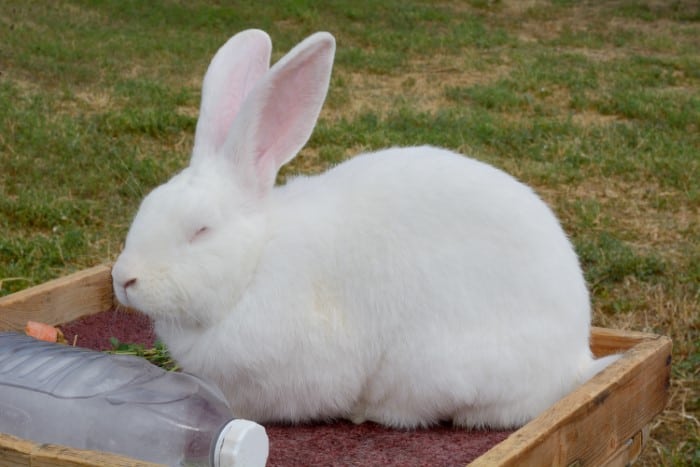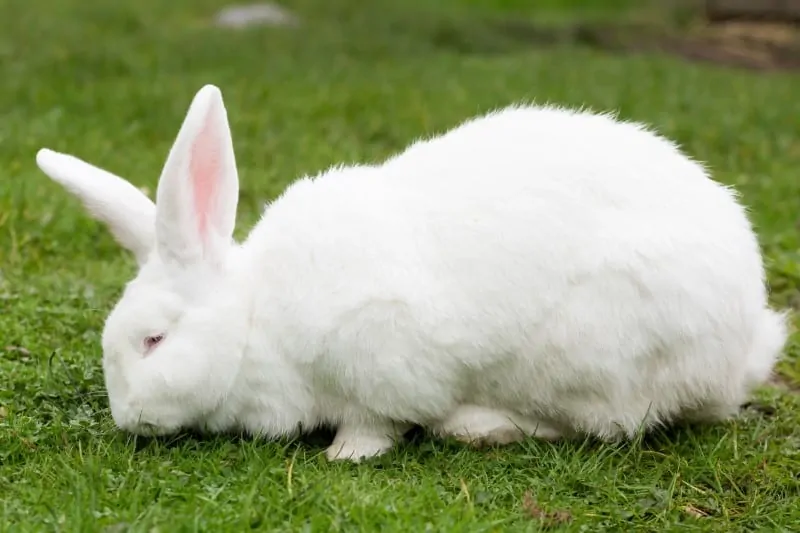Giant rabbits are known for having exceptional temperaments. These huge gentle bunnies have been earning popularity among pet owners. Such is the case of the Flemish Giant rabbit. As a general rule, the bigger the rabbits are, the calmer they tend to be. Now, the main question is: How to care for Flemish Giant rabbits?
If you are going to keep a Flemish Giant as a pet, first of all, make sure that you are going to be able to look after it correctly and give it what it needs. Flemish Giant rabbits are unique and are far from the concept we all have of an ordinary rabbit.
If you are interested in Flemish Giant rabbits, but you are not convinced that it is the right breed for you, first, you need to know that this breed requires more care and resources than other rabbits. But first, let’s learn a little about these majestic creatures.
Let’s Meet the Flemish Giant
Flemish Giant is one of the oldest and largest rabbit breeds in existence. The first rabbits belonging to this breed originated in the Flemish region of Belgium during the 16th century.
The life expectancy of these giant bunnies is 5 to 7 years, but as with other rabbit breeds, it all depends on the diet and the attention given to them.
Physical Characteristics
Flemish Giant is the largest breed of rabbits. It is precisely their size that has made them so popular.
When mature, they will weigh more than 14 pounds; but some can reach more than 22 pounds when fully grown. That is a lot of weight for a bunny! Also, there is a difference in weight, between males and females, males are usually bigger.
Their bodies are long, broad, and very robust. Seen from above, they may appear to have a rectangular shape. Their limbs are strong and muscular, especially the hind legs. They have a quite curved column and rounded tails.
Flemish Giant bunnies are distinguished for having broad, large heads with prominent dewlaps. They have long, V-shaped ears that can reach a length of 20 cm.
Their coat is smooth and of medium length, and according to the official standards, come in a variation of colors like white, sandy, fawn, light gray, steel gray, black, and blue.

Flemish Giant Temperament
Despite their intimidating physical appearance, Flemish Giant rabbits are the most docile, calm, and relaxed creatures in the world. These rabbits can be very friendly to both people and other animals, although some time of adaptation will always be necessary. It is advisable to encourage good relationships from a young age.
It is common to see rabbits being very active. However, with the Flemish Giant, it is the opposite. Unlike other rabbit breeds, the Flemish Giant is very calm. This breed of rabbits does not like running or jumping. They prefer a quiet life and lying down resting. They are not very agile and do not move much, probably because moving is more difficult for them because of their large size.
How to Care for Flemish Giant Rabbits
Now that we have seen the most relevant traits of these fantastic rabbits, it’s time to review what needs to be done to take care of them. To assist you with this matter, we are going to focus on three main aspects: feeding, cage, and space availability.
Feeding A Flemish Giant
The diet of a Flemish Giant rabbit is the same as that of smaller breeds but in higher quantities. The only thing that differentiates a Flemish Giant from other rabbit breeds is its size and weight. For them to reach their maximum potential, and enjoy good health and quality of life, we must provide them with a healthy and balanced diet that covers all their nutritional needs.
What is the Recommended Diet for a Flemish Giant?
Due to their large size, these rabbits need a great deal of food in comparison with smaller breeds. Flemish Giant rabbits need to ingest a great deal of protein and fiber, and so we should give them more quantity of pellets, an endless supply of hay, and a great deal of fresh and clean water.
Their diet must be balanced so that they do not become overweight. These are some of the recommendations regarding their feeding:
- Ideally, provide a protein content of 16 to 18%. Alfalfa is a good source of protein for rabbits. But it should be offered with caution as its high calcium and caloric content could cause the rabbit to gain weight, its urine to thicken and darken, or its excrement to become loose or wet.
- The fiber content will mainly depend on other supplements, such as the type and amount of hay. If you regularly feed your rabbit a decent portion of premium-quality hay then, feeding a lower fiber pellet ratio should be fine. On the other hand, if you are feeding hay that is low in fiber, you should then provide pellets with a high fiber content to complement.
- Your giants should eat hay regularly to improve their digestive transit.
- Flemish Giant rabbits require high-quality feed so they can get all the vitamins, minerals, and nutrients they need.
- They also require an inexhaustible supply of fresh, clean water.
- Since they tend to be overweight, you should limit their fruit and vegetable intake, which are high in carbohydrates.
You should bear in mind that Flemish Giant rabbits are sedentary animals, so more attention must be paid to an excessive intake of calories, proteins, and minerals. Flemish Giant tend to thrive on higher amounts of protein and fiber.

Overweight Problems
Since these rabbits are already big, we don’t want them to get massive. If our rabbit starts to eat too much, it will inevitably get fat because its activity level is very low.
To avoid our rabbit developing overweight problems, we must control two factors: monitor the caloric intake, and promote physical activity. Here are some recommendations:
- We do not recommend feeding them potatoes, white bread, cauliflower, cabbage, lettuce, watermelon, beets, rice, nor any sugary foods. Vegetables and fruits should be offered in moderation because of their high carbohydrate content.
- Seedless apples, bananas, barley, cucumbers, dandelions, papaya, pineapple, zucchini, as well as fruit tree branches can be offered as treats, but in moderation. These products are not only nutritious, but the rabbits also love them.
- Even though giant rabbits are not as agile as other species, we can encourage them into physical activity, capturing their attention with some kind of toys they like.
Remember that Flemish Giant are animals that perform very little or no physical activity, so their caloric expenditure is minimal. If your rabbit gets overweight, it may develop illnesses and serious problems in the spine.
Adequate Room Space
It is not the same to own a rabbit as to own a Flemish Giant, as far as room space is concerned. These bunnies are not meant for small spaces. If you are considering acquiring one of these rabbits, keep in mind that these rabbits will grow to the size of a medium-sized dog.
Remember that these animals are intended to live in the countryside. Even though many have been raised since they were born in captivity, they still have their instincts to survive. These rabbits must have enough space to move around in search of food. Their nature should be respected and should not be negatively affected by their stay at home.
Although this breed of rabbit indeed spends most of its day lying down, they also have some need for movement and displacement. It is necessary to take them out of their enclosure at least a few minutes a day so that they can get some exercise and keep their muscles toned. It is advisable to take them out of their cage frequently so that they can enjoy the freedom of wandering around the house.
Another aspect to consider is the size of the cage. The cage should not be too small, or your rabbit will not be able to move. So you should think in advance about the ideal place in your house where you can place a large cage without any problems.

A Hutch According to Their Size
Just like any other bunny, Flemish Giant rabbits will also need a hutch. As long as there’s a supervisor, it may be okay to let your rabbit wander around the house. But in the absence of someone who is looking after them, leaving them free around the house may lead to problems.
If you have to leave them alone for a day or at night, then a hutch is the best option according to their needs.
Conventional rabbit hutches are not suitable for Flemish Giant rabbits, so it is necessary to recur to giant rabbit hatcheries or large aviaries. These must be comfortable and must be adapted to their size so that your rabbit can move freely and not be overwhelmed.
Suitable Dimensions
The most important feature about the hutch is that it should be wide enough so that your rabbit can move around freely and safely. Many Flemish Giant rabbit breeders agree that the minimal dimensions of a hutch must be at least 3 feet by 4 feet.
The cage should be more horizontal than vertical. It’s convenient that it’ s only one level and should not be too high so that the rabbit does not have difficulties when trying to get in or out.
For your convenience, the cage can be provided with a removable bottom tray with urine protection and a mesh or floor grid for easier hygiene and better support. This feature will make it easier for you to clean. The enclosure should be cleaned every two or three days for hygiene reasons, and the floor should be lined with straw, hay, or grass.
Some cages include a divider that separates the area where you will place the litter box from the area where the rabbit usually stays.
Other Considerations
Their large size makes Flemish Giant rabbits more sensitive to heat, so make sure they are kept in cool places at a temperature slightly below 70 ºF (21 ºC) and with little humidity.
They are also more prone to suffer from back injuries if they fall or are handled incorrectly.
Remember that every rabbit, just like all other pets, needs vaccinations and regular visits to the vet. Do not hesitate to visit the vet whenever you detect symptoms of illness or unusual behaviors.

